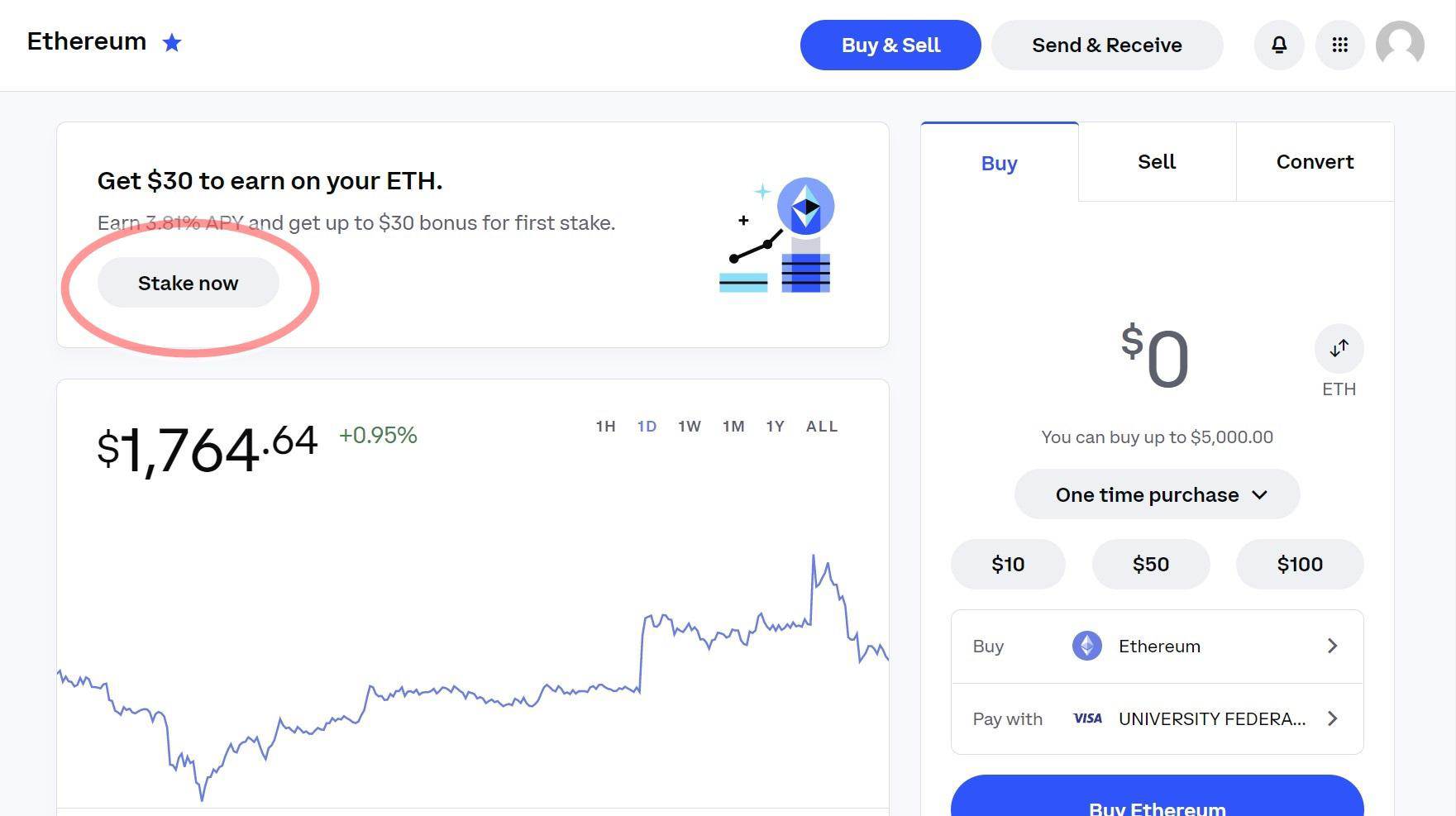
Executive Summary: Staking cryptocurrency can seem daunting, but there are simple ways to stake your PoS crypto assets to earn interest. Centralized exchange and LSDs can make staking very simple, while delegation is a bit more advanced. We go over all the staking methods, where to stake, and some of the best staking cryptos in this beginner’s guide to staking cryptocurrency.
There is a way to reap the rewards of mining without investing in expensive hardware or maintenance. This is cryptocurrency staking, and it is a convenient way to generate interest income.
In this guide, you’ll learn the basics as well as the benefits of staking.
How Do You Stake Crypto?
The simplest way to start staking as a beginner is via an online crypto exchange or platform, with these easy steps:
- Sign up on an online exchange/staking platform
- Compare different crypto staking rates – APY, lock-up period, minimum stakes, etc.
- Buy the required number of crypto assets
- Enter the amount you wish to stake
- Confirm to add crypto to staking pool


What is Crypto Staking?
Crypto staking is a way to earn more cryptocurrency – like earning “interest” – while still holding onto your original investment. To launch the staking process, individuals put their cryptocurrency into a special digital wallet that supports staking, leaving it there for a set amount of time.
During this time, the network uses the locked cryptocurrency to verify transactions and maintain the security of the blockchain. In exchange for providing this service, crypto holders earn more cryptocurrency as a reward (i.e., “staking rewards”).
Staking can be a way to earn interest income on cryptocurrency holdings without having to actively trade or mine it. It can also be a more environmentally friendly alternative to mining, which uses great amounts of computing power and, thus, a lot of energy. However, it does come with some risks, such as the possibility of losing some or all of the staked cryptocurrency if the network experiences issues. This is why individuals who want to stake should get familiar with the rules, and use trusted blockchains with a long history of success.
Staking is possible exclusively on blockchains that employ the Proof of Stake (PoS) consensus algorithm – a mechanism that enables network participants to reach consensus on which transactions should be validated and added to newly created blocks.
Unlike bitcoin’s Proof of Work (PoW) algorithm, which relies on complex calculations carried out by powerful specialized chips that use a great deal of energy, the PoS consensus method is a more energy-efficient, eco-friendly alternative to PoW’s mining.
If you have PoS crypto investments sitting idle, staking is an option to earn additional income. It is similar to earning interest on a fixed deposit but with the potential for higher interest, along with higher risk.
How Crypto Staking Works
Staking involves holding a certain amount of cryptocurrency in a specific type of digital wallet and locking it up. This process benefits the blockchain network in two ways:
- Security
- Transaction verification
By staking, token holders contribute to the blockchain network, and as a reward, they earn more of the same cryptocurrency being staked.
To participate in cryptocurrency staking, users start by committing a certain amount of their cryptocurrency to the network. The network then selects validators from among these participants to confirm blocks of transactions. The more cryptocurrency a user commits, the higher their chances of being chosen as a validator.
As each block is added to the blockchain, new coins are created and distributed as rewards to the validator of the block. Typically, these rewards are paid in the same cryptocurrency that the participants have staked.

Staking rewards can vary depending on factors like the amount staked, the length of time the cryptocurrency is staked, and the demand for the cryptocurrency.
Different Ways of Staking
There are four primary ways in which you can participate in staking.
The first and easiest way is delegating, a popular option for smaller crypto investors who don’t want to spend the money and effort to operate a validator. Instead, crypto holders delegate their coins to a validator, which pools the staking funds from multiple investors.
When crypto holders delegate, they essentially lend their crypto assets to the validator, which uses it to participate in the network’s staking process. In exchange for their delegation, investors receive a portion of the staking rewards earned by the validator.
The amount of rewards depends on the amount of the delegated cryptocurrency, and the share it represents from the validator’s total stake.
Delegating implies entrusting your cryptocurrency to a third party. Therefore, it’s essential to perform due diligence and pick a trustworthy validator or node with a good track record and reputation in the network.
The second method is to stake your tokens through a pooled staking service. There are many of these, including Stake.fish (covered in more detail below) and RocketPool. Pooled staking combines several validators into a single pool with the goal of greater staking rewards. The greater the number of tokens held in a single pool, the greater the chance that the pool will receive a staking reward. Pools are a bit more advanced when compared to delegation, but are worth investigating.
A third method for staking, which is becoming increasingly popular, is through liquid staking services (also called liquid staking derivatives, or LSDs). Liquid staking through a platform like Lido (covered in more detail below) allows token holders to receive staking rewards while still retaining access to their tokens. This provides greater flexibility and efficiency when staking. That said, liquid staking may be a bit beyond those who are completely new to staking.
The fourth and most advanced method for staking is as a validator. You run your own staking node using advanced technical skills and your own hardware (which must always be kept online). The advantage is higher rewards and voting/controlling rights on some blockchains.
But becoming a validator is not easy; you have to invest higher sums just to qualify. For instance, to become a validator on the Ethereum blockchain, you need to commit 32 ETH. And of course there’s the technical knowledge required. Running a validator node is certainly not for most beginners.
Popular Staking Tokens
Below are six of the more popular tokens to stake. Their popularity stems from a number of things, including the strength of the project, the APY offered, or the large market cap and liquidity of the token. Tokens are listed in order of total percentage of tokens staked.
 Tezos (XTZ)
Tezos (XTZ)
Launched in 2014, Tezos is a programmable cryptocurrency with support for smart contracts. It has a self-amending mechanism to avoid “hard forks.” While the total market cap is a bit low at $1 billion, Tezos is quite popular due to its future potential.
To become a full validator or “baker” on the Tezos blockchain, you need a minimum of 6,000 XTZ and an initial lock-up period of 14 days. But if you don’t have that many tokens to spare, you can participate in the delegator pools for annual percentage yields (APY) of around 3%.
 Solana (SOL)
Solana (SOL)
This particular blockchain launched with a heavy focus on decentralized finance (DeFi). The SOL tokens were first launched to the public in 2020 for $0.22. In 2021, SOL was worth close to $250, placing it in the list of the top crypto with a market cap of $74 billion. SOL was hit by the “crypto winter,” but it’s still one of the largest cryptocurrencies as of this writing, with a $9 billion market cap.
There is no minimum limit required to run a validator node on the Solana blockchain. Both delegator pools and validators have a lock-up of 5 days. The shared rewards from a pool can bring in around 7% APY.
 Cardano (ADA)
Cardano (ADA)
Cardano is yet another “Ethereum-killer” that has been around for nearly a decade. This PoS blockchain with smart contracts and improved scalability launched in 2015. As of this writing, it is one of the top ten largest cryptos in terms of market cap, with $14 billion.
Staking on ADA has several advantages – there is no minimum limit required and no lock-in period. Join any large and reputable delegated pool, and you can start earning your rewards with minimum fuss. The APY for Cardano staking is around 5%.
 Polkadot (DOT)
Polkadot (DOT)
Polkadot uses a complex architecture of multiple chains to avoid the high fees and congestion plaguing other blockchains like Ethereum. Launched in 2020, the blockchain has zoomed to the top 15 cryptos list with a market cap of $7.6 billion.
Staking on this blockchain uses the native token DOT. The amount needed is dynamic and is based on how much stake is being put behind each validator, the size of the active set and how many validators are waiting in the pool. The current requirement is 993 DOT.
To join a delegated pool, you need a minimum of 1 token and a lock-up period of 28 days for what have historically been high APYs.
 Binance (BNB)
Binance (BNB)
Binance is the world’s largest cryptocurrency exchange. The platform launched a native token in 2017. With a value of $320 per coin and a market cap of $50.5 billion, the Binance token is only behind bitcoin, Ethereum, and USDT on the list of largest cryptos.
For a high return on staking, BNB is a great choice with an APY of 12.7% on delegation pools, with a minimum 1 BNB needed. To run a validator node, you will need a whopping 10,000 BNB tokens. Both options come with a minimum lock-up of 7 days, although longer periods result in higher reward rates.
 Ethereum 2.0 (ETH2)
Ethereum 2.0 (ETH2)
After years of anticipation, Ethereum finally upgraded to PoS, with the Merge upgrade in September 2022. Many people expect the shift to help the blockchain overtake bitcoin as the most valuable crypto by 2023-24, but it remains to be seen whether Ethereum manages to dominate the crypto market. At this writing, ETH has a market cap of over $200 billion, which is about 40% of bitcoins.
Validator nodes on the new PoS blockchain require 32 ETH tokens and a lock-up of 365 days. Delegate staking pools don’t have any minimum requirements or lock-up periods, making them ideal for beginners. APYs for ETH staking will vary from one platform to another. We have many of the top staking platforms and ETH APYs here.
Where Do You Stake Coins?
There are three main places where you can stake PoS cryptos:
- Exchanges (CEX) – most leading cryptocurrency exchanges such as Binance and Coinbase provide easy staking as an option to their users.
- Staking Platforms – these are online “staking-as-a-service” platforms that focus entirely on crypto staking pools in exchange for a percentage commission.
- Private Wallets – this method using offline crypto wallets/hardware wallets is called cold staking.
Let’s take a closer look at some popular staking options from these three categories:
Centralized Exchanges
 Binance (CEX)
Binance (CEX)
Binance is the largest, most popular crypto exchange worldwide. Apart from staking its native Binance Coin, you can pick from over 90 staking options, with APY ranging from 2% to 30% or more. Staking information for Binance can be found here, along with a good explainer video of the process.
 Coinbase (CEX)
Coinbase (CEX)
Established in 2012, Coinbase is a fully-regulated crypto exchange based in the United States. The platform offers staking on all major PoS cryptos like ETH2 and Tezos. The NASDAQ-listed company is a top alternative to Binance, especially for US customers. Get started by opening a Coinbase account and visiting their Earn page for available assets to stake.
Hardware Wallets
 Ledger (wallet)
Ledger (wallet)
Ledger is the most popular brand for hardware crypto wallets. Using the Ledger Live app, you can connect to over 15 different Web3 services, many of which allow staking. The rewards are delivered on the Ledger Live app or to an external wallet. This makes most of the popular tokens available for staking through your Ledger wallet, including Ethereum, Polkadot, and Solana.
 Trezor (wallet)
Trezor (wallet)
Created in the Czech Republic in 2011, Trezor is the world’s first digital hardware wallet for cryptocurrencies. Trezor also supports crypto staking, but not directly. Instead you can connect the Trezor to a wallet like Exodus to use as a staking interface. More advanced users can also connect the Trezor to a staking service like Allnodes.
Staking Services
 Lido
Lido
Lido is a secure protocol for liquid staking that is designed to support multiple PoS cryptocurrencies, including Ethereum (ETH), Solana (SOL), Polygon (MATIC), Polkadot (DOT), and Kusama (KSM). Lido, launched in 2020, aims to solve a major problem of the PoS staking ecosystem, which has to do with illiquidity.
As a rule, once a crypto user starts staking, the assets are typically locked up and cannot be used or traded until the staking period is over. Lido aims to address this issue by providing a way for users to stake their cryptocurrency and receive a so-called “liquid staking token” (LDO) in return. Liquid staking tokens can eventually be traded or put to work in decentralized finance (DeFi) applications.
This makes it easier for users to participate in staking and access the benefits of staking rewards without having to sacrifice liquidity.
While Lido supports multiple PoS blockchains, the staking service is focused on Ethereum, which is the second-largest cryptocurrency by market cap and dominates the DeFi space.
 Stake.fish
Stake.fish
Stake.fish is a staking platform for cryptocurrencies where crypto holders can pool their assets and earn rewards. Stake.fish supports staking on 22 PoS blockchains, including Cardano, Cosmos, Ethereum, Polkadot, Polygon, Solana, and Tezos. At the time of writing, over 500,000 ETH is staked with the platform.
Launched in 2018, stake.fish has attracted over $1 billion worth of cryptocurrency for staking from both retail and institutional investors.
How to Stake Coins: Step by Step Guide
The steps for staking will vary depending on the platform/method you prefer. However, the initial steps remain the same across all methods:
Basic Steps
- Choose a Crypto Asset: look at factors like APY rewards, minimum stake, lock-up periods, and other aspects of the crypto asset. Do adequate research before picking up unknown/obscure cryptos.
- Decide Validator or Delegator: for some crypto assets, the validator requirements are quite steep. They also require desktop PC hardware with 24/7 internet connectivity. Setting up the node also requires advanced skills. Most beginners will choose the delegation route. In this case, it is best to choose a delegator with a good history and reputation.
For Crypto Exchanges
- Create an account: visit the crypto exchange and sign up for an account. Link your crypto wallet to your account.
- Buy PoS Crypto Assets: if you don’t already have cryptos in your wallet, buy them from the exchange.
- Go to Staking Page: find the dedicated staking page for the crypto on the online exchange. Coinbase is here, and Binance here.
- Tweak Your Preferences: Some exchanges offer different pools with varying lock-ups, APYs, and other special features.
- Enter Stake: enter the amount you want to stake and confirm the order using the button provided.
For Private Staking (Crypto Wallets)
- Download App: there are software wallets that support staking directly on the app. Some examples are Exodus and Trust Wallet.
- Pick an Asset that Supports Staking: such as Ethereum, Cardano, or Solana. Make sure to hold your crypto assets on the app.
- Set Stake: Launch staking by tapping on “earn now” or “start earning.” You can calculate potential rewards directly on the app.
Delegating (Platforms)
- Select a staking platform, such as Lido or Stake.fish. Some platforms, such as Stake.fish, require registration, so make sure to register.
- Go to the staking page that lists all supported coins for staking. Choose a crypto asset that you want to stake.
- Connect a wallet where you have your cryptocurrency stored. Some staking platforms, such as Lido, support multiple wallets, including MetaMask, Ledger, Trust Wallet, and Exodus, among others.
- Start the staking process after confirming the amount and checking the reward rate.

Mining vs. Staking
For individual investors, we consider staking to be a much better alternative to crypto mining. The energy issues associated with mining are one of the major reasons why Ethereum shifted to PoS. After the shift, the Ethereum blockchain saw its energy costs reduced by 99%!
The following table illustrates the main differences between mining and staking on cryptos:
| Mining | Staking |
| Used on cryptos with proof-of-work algorithms | Used on cryptos with proof-of-stake algorithms |
| Requires powerful computers and GPUs | Any computer is fine |
| Miners use computing power to validate transactions | Stakers commit their crypto assets to facilitate the validation process |
| Requires a lot of energy/electricity | Requires only a fraction of the energy used for mining |
| Does not require crypto assets to start mining | Cryptocurrency ownership is essential for staking |
Both methods also have some striking similarities, as listed below:
- Both allow pooling of resources for low but steady rewards
- Rewards are provided in the native cryptocurrency
The STAKEaway: How to Make Money by Staking
Staking doesn’t involve steep upfront/running costs of mining: no GPUs or mining rigs required. It does not spike your energy bills and is extremely eco-friendly. For beginners, the best option to try their hands at staking is via an online platform.
Like all crypto-related investments, staking comes with a fair degree of volatility and risk. Pick established crypto assets, and avoid less-known altcoins to minimize your risk exposure.
Consider starting small with popular assets like Ethereum (ETH) or Cardano (ADA) to learn the basics. Then, do thorough research and always exercise an abundance of caution when investing/staking crypto assets.
To learn more about earning money on your crypto investments, including the best staking rates, subscribe to our Bitcoin Market Journal newsletter.
- SEO Powered Content & PR Distribution. Get Amplified Today.
- Platoblockchain. Web3 Metaverse Intelligence. Knowledge Amplified. Access Here.
- Source: https://www.bitcoinmarketjournal.com/staking-cryptocurrency/



